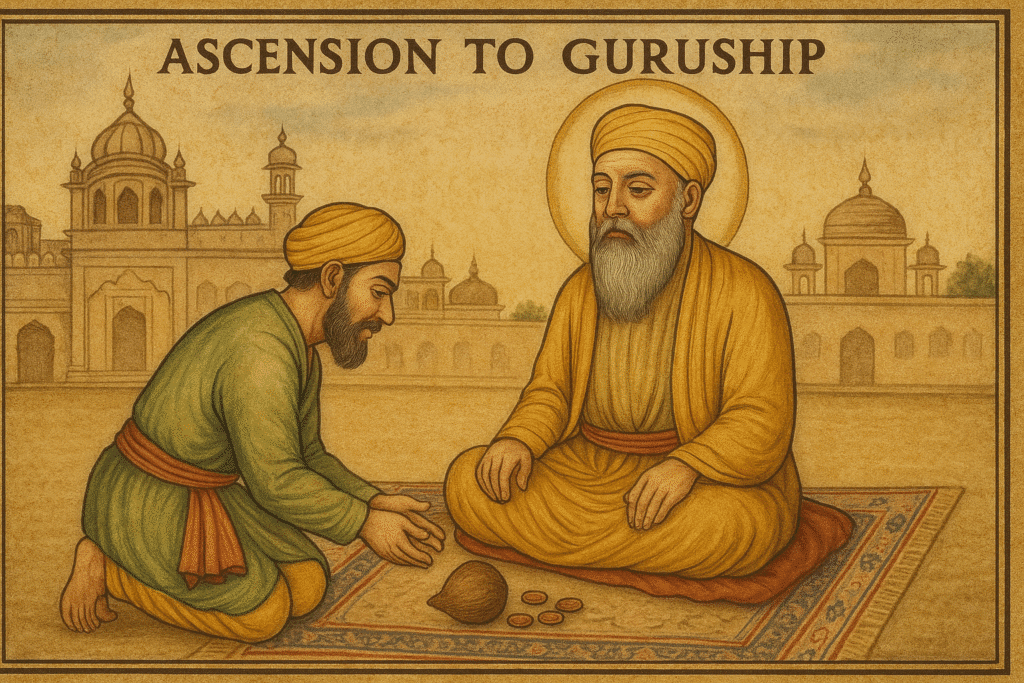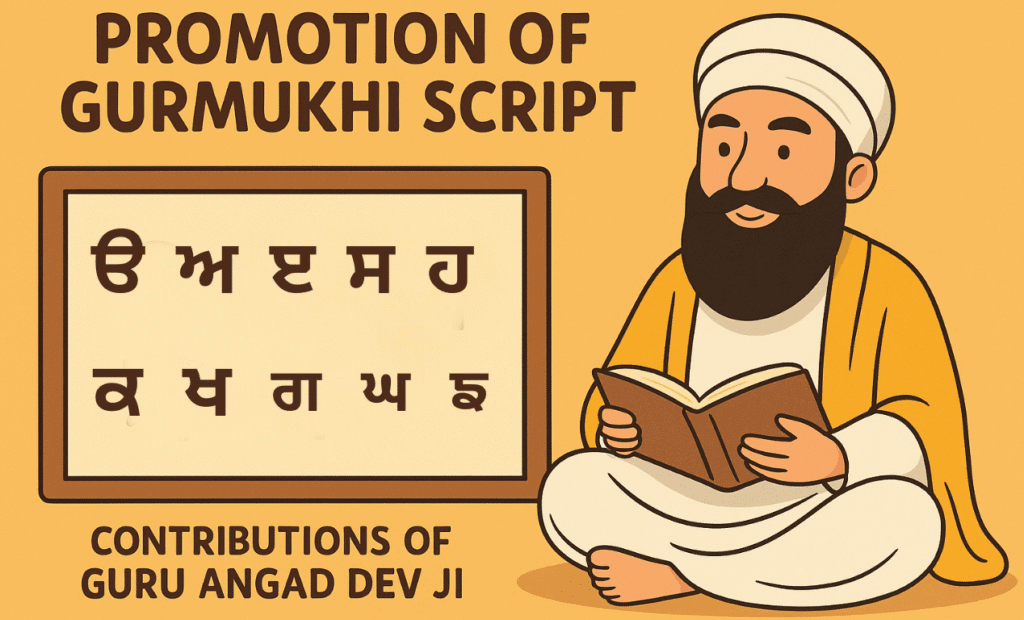
Sri Guru Angad Dev Ji, originally known as Bhai Lehna Ji, succeeded Guru Nanak Dev Ji in 1539 after the First Nanak merged with the Immortal. He played a significant role in the development of Sikhism and the continuation of Guru Nanak’s teachings. Guru Angad Dev ji popularized and made perfect use of the Gurmukhi script, and worked hard to expand the institutions started by the first Sikh Guru, Sri Guru Nanak Dev Ji—Sangat (holy congregation) and Pangat (community kitchen) , both of which we have already discussed in our previous article.
Guru Angad Dev Ji also did remarkable work in shaping the identity of Sikhism. One of his most important contributions was clearly separating Sikhism from the Udasi sect, which had been started by Baba Sri Chand Ji, the son of Sri Guru Nanak Dev Ji. In addition, he collected the hymns of Guru Nanak and added some of his own compositions, which deeply impacted the people of his time and helped strengthen their faith in the Sikh way of life.
Table of Contents
Birth and Parents
Sri Guru Angad Dev Ji was born into the family of Bhai Pheru Mal Ji, who was an ordinary trader by profession, and his mother Sabhrai Ji, belonging to the Trehan Khatri family. However, in some texts, his mother’s name has been recorded differently—as Daya Kaur, Mansa Devi, or Ramo. She was a deeply religious woman whose spiritual nature was passed down to her son. Her thoughts and values greatly influenced young Bhai Lehna Ji’s early life.
He was born in a village near present-day Sri Muktsar Sahib called Matte-di-Sarai on March 31, 1504 A.D.
Childhood and Marriage
After his birth, Bhai Lehna Ji’s parents left Matte-di-Sarai and moved to the village of Harike. Later, they settled in Khadur Sahib, which is located in today’s Tarn Taran district. Most of his childhood was spent in Harike and Khadur Sahib. From a very young age, he showed signs of deep spirituality and religious inclination.
In his early years, he was a devoted follower of Mata Durga and used to visit the famous Jawalamukhi Temple in the Kangra district (now part of Himachal Pradesh) every year along with a group of devotees (jatha ). However, despite his sincere devotion, he felt that his search for truth remained incomplete.
One day in Khadur Sahib, he heard the recitation of Sri Guru Nanak Dev Ji’s Asa di Var being sung by Bhai Jodha Ji, a devoted follower of the Guru Nanak Dev Ji. This experience deeply moved him, and he decided to meet Guru Nanak Dev Ji in person.
At the age of 15, in January 1520, Bhai Lehna Ji married Bibi Khivi Ji, daughter of Devi Chand Marwaha, a Khatri by caste, from the village of Sanghar in present-day Tarn Taran district. Over time, they were blessed with two daughters—Bibi Amro and Bibi Anokhi—and two sons—Datu and Dasu.
Becoming a Disciple of Sri Guru Nanak Dev Ji
When Bhai Lehna Ji heard the recitation of Asa di Var at Khadur Sahib from Bhai Jodha Ji, it awakened something within him. The next year, when he set out again on his pilgrimage to Jawalamukhi, he stopped at Kartarpur to meet Sri Guru Nanak Dev Ji.
Upon meeting the great Guru, he was deeply moved by his personality and teachings. From that moment on, he became a devoted follower of Guru Nanak and committed himself fully to serving him and spreading the message of Sikhism.
Ascension to Guruship

Bhai Lehna Ji served Sri Guru Nanak Dev Ji with all his heart and soul. He dedicated himself completely to the Guru’s service and lived a life of humility, hard work, and devotion.
During his time in Kartarpur, Guru Nanak Dev Ji tested his disciples repeatedly, especially in terms of their devotion to the formless God and their understanding of the divine knowledge he preached. These tests are mentioned in many Janam Sakhis (biographical accounts) of Guru Nanak Dev Ji.
Bhai Lehna Ji passed each test with patience and sincerity, proving his deep commitment and love for the Guru’s path. Finally, Guru Nanak was fully satisfied with Bhai Lehna Ji’s devotion and appointed him as his successor.
The formal passing of Guruship took place by placing a coconut and five copper coins before Bhai Lehna Ji, bowing before him, and declaring him his spiritual heir. Then, Guru Nanak gave him a new name—Angad , meaning “a part of my own body.”
From that day onward, Bhai Lehna Ji became Sri Guru Angad Dev Ji , the Second Nanak. This historic event took place on September 7, 1539 , and is considered one of the most important moments in Sikh history.
Contributions to Sikhism

Promotion of Gurmukhi Script
One of the major contributions of Guru Angad Dev Ji was the promotion and standardization of the Gurmukhi script. While this script had been introduced by Guru Nanak, it was under Guru Angad’s guidance that it gained widespread acceptance and use among the Sikh community.
He encouraged its use in schools and writings so that the holy hymns could be preserved accurately and made accessible to the common people.
Expansion of Institutions
Guru Angad Dev Ji continued and strengthened the institutions established by Guru Nanak:
- Sangat : He emphasized the importance of gathering together for prayer, singing hymns, and meditating on the Name of God.
- Pangat : He reinforced the practice of eating together without any discrimination of caste, creed, or background, promoting equality and unity.
These practices became central to Sikh life and remain vital parts of gurdwaras around the world.
Preservation and Collection of Hymns
Understanding the importance of preserving the sacred compositions of Guru Nanak, Guru Angad Ji traveled far and wide to collect authentic hymns. He ensured their accuracy and integrity and even composed several hymns himself, which were later included in the Guru Granth Sahib .
His efforts helped safeguard the spiritual legacy of Guru Nanak and ensured that the message of truth, compassion, and devotion continued to reach people across generations.
Clarification of Sikh Identity
During his time, there was a growing need to distinguish Sikhism from other contemporary movements, especially the Udasi sect founded by Baba Sri Chand, the son of Guru Nanak.
Although Baba Sri Chand was respected for his ascetic lifestyle, his path was different from the householder-based philosophy of Sikhism. Guru Angad clearly defined the unique identity of Sikhism, emphasizing a life of active engagement, righteous living, and service to humanity.
This clarification was essential in establishing Sikhism as an independent religion rather than a reformist movement within Hinduism.
Establishment of Schools
Recognizing the importance of education, Guru Angad set up schools where children were taught reading, writing, and moral values using the Gurmukhi script. These schools laid the foundation for a literate and informed Sikh community, promoting both spiritual and secular knowledge.
Sri Guru Angad plays a central role in the history of Sikhism, as the second Guru who transformed the ideals of Guru Nanak Dev Ji into a living tradition. He promoted the use of the Gurmukhi script, compiled sacred hymns, and strengthened the institutions started by Sri Guru Nanak Dev Ji, such as Sangats and Pangats, with the help of his wife, Bibi Khivi Ji. He also gave a distinct identity to Sikhism, leaving an indelible mark on the community.
For other parts of his life after Guruship, he started the Mal Akhara , and refined the thirty-five letters of the Punjabi alphabet originally composed by Guru Nanak Dev Ji. He gave them a new shape, order, and precise structure, making them accurate and suitable for scientific use. He also played a key role in expanding Guru Ka Langar .
